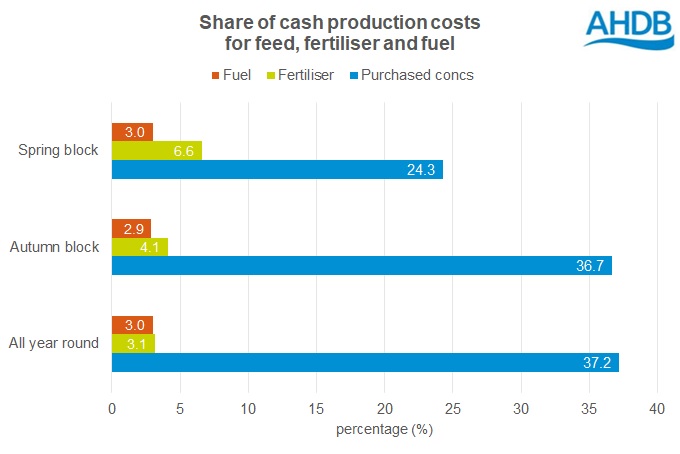Pressures on cash will vary by system
Thursday, 24 March 2022
While cash costs of production are rising for all dairy farms, they will be felt in different ways depending on the system you operate.
Autumn block and all-year-round calvers will have the most exposure to rising feed prices. On the other hand, spring block calving systems are subjected to higher fertiliser costs given their higher reliance on grazing.
The relative share of fuel cost in budgets is similar across all systems as this is more related to equipment than feeding systems.

Currently the largest pressure on cash will be coming from fertiliser purchases for those who haven’t bought ahead and need to buy now. Despite the high costs, it may still be viable to apply fertiliser on some grasslands to maximise grass growth. You can assess whether it’s worth purchasing fertiliser using the AHDB cost-benefit calculator for grasslands.
For most dairy farmers, higher milk prices will be helping to compensate for larger cash outlays. Between Janaury and April, average milk prices on market-related contracts have risen by 4.0-6.0ppl
Prices on retail aligned contracts, which are linked to production costs, have risen by much less. Announced increases have totalled between 0.8ppl to 1.43ppl over the first four months of 2022. Sainsbury’s have moved to monthly reviews, while Tesco’s next quarterly adjustment is due in May.
Because of the use of 6- or 12-month rolling averages of input costs, they have not yet accounted for the full impact of rising costs, and have not kept up with rapid increases in the value of milk on markets.
Later in the year, the impacts of reduced fertiliser use on cereals crops this spring, whether due to high cost or lack of availability, will feed through into higher feed prices in the livestock sector.
Over the winter months, feed costs account for a larger share of expenses, and there is little prospect of lower prices. At this point, cash flows could be pinched again, although how seriously will depend on how well milk prices keep pace with increasing costs, and the success of silage production over the summer.
Further resources on grassland management:
Sign up to receive the latest information from AHDB.
While AHDB seeks to ensure that the information contained on this webpage is accurate at the time of publication, no warranty is given in respect of the information and data provided. You are responsible for how you use the information. To the maximum extent permitted by law, AHDB accepts no liability for loss, damage or injury howsoever caused or suffered (including that caused by negligence) directly or indirectly in relation to the information or data provided in this publication.
All intellectual property rights in the information and data on this webpage belong to or are licensed by AHDB. You are authorised to use such information for your internal business purposes only and you must not provide this information to any other third parties, including further publication of the information, or for commercial gain in any way whatsoever without the prior written permission of AHDB for each third party disclosure, publication or commercial arrangement. For more information, please see our Terms of Use and Privacy Notice or contact the Director of Corporate Affairs at info@ahdb.org.uk © Agriculture and Horticulture Development Board. All rights reserved.

